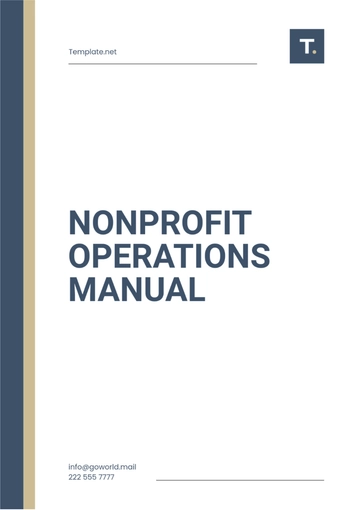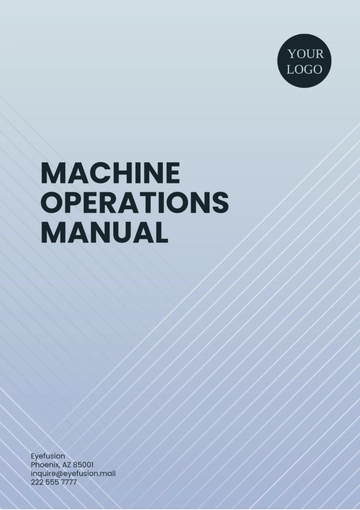Free Advertising Digital Media Operations Manual

This manual is designed to provide guidelines to understanding the complexities of advertising digital media operations. From the formulation of effective advertising strategies to the execution and measurement of outcomes, this manual covers everything necessary to successfully navigate the realm of digital media.
1. Introduction
Purpose of the Manual
The Advertising Digital Media Operations Manual stands as a guide for digital advertising professionals, providing guidance through the multifaceted process of planning, executing, and refining digital media advertising campaigns. The purpose of this manual is to strengthen individuals and entities with the strategic frameworks that mixes advertising objectives with overall business goals, building the foundation for success.
Target Audience
This manual is tailored with precision with the goal to cater to the discerning needs of digital advertising professionals, from seasoned strategists to emerging talents. Whether honing skills or seeking advanced strategies, this manual ensures that its content resonates with the diverse spectrum of professionals engaged in digital advertising.
2. Campaign Planning and Strategy
Defining Advertising Objectives
Clearly articulate and define the overarching advertising objectives, ensuring alignment with the broader organizational goals. This includes specific, measurable, achievable, relevant, and time-bound (SMART) objectives.
Target Audience Identification
Delve into meticulous audience profiling, incorporating demographic, psychographic, and behavioral factors to create a nuanced understanding of the target audience. This section emphasizes the importance of leveraging data analytics for refined targeting.
Market Segmentation Strategies
Strategic Segmentation Techniques: Expound upon advanced market segmentation strategies, going beyond basic demographics to explore psychographic nuances, regional influences, and emerging market trends. Highlight the significance of adapting strategies to diverse market segments.
Budget Allocation and Resource Planning
Elaborate on a comprehensive framework for budget allocation and resource planning. This includes methodologies for optimizing resources to achieve maximum impact, with considerations for both financial and human resources.
3. Ad Creative Specifications
In this section, meticulous attention is given to the specifications governing the creation of captivating and impactful ad creatives. Adhering to these guidelines ensures the delivery of visually compelling content that resonates with the target audience across diverse digital platforms.
A. Visual Design Guidelines
Image Requirements
Aspect | Recommendation |
Format | JPEG, PNG, GIF |
Resolution | Minimum 300 dpi |
Size | Optimized for platform |
Color Palette | Consistent with brand colors |
Typography | Readable and brand-aligned |
Video Specifications
Aspect | Recommendation |
Format | MP4, AVI, MOV |
Resolution | HD (1080p) or as per platform specs |
Duration | Concise, adhering to platform limits |
Audio | Clear, relevant, and appropriately mixed |
Branding And Messaging | Prominent, with a compelling call to action |
B. Multimedia Element Requirements
To ensure an engaging user experience, the inclusion of multimedia elements is essential. The following guidelines provide a framework for incorporating diverse media types:
Interactive Features
Aspect | Recommendation |
CTA Buttons | Clearly defined and strategically placed |
Animation | Subtle, enhancing without distraction |
User Interaction | Intuitive and user-friendly design |
Responsiveness | Optimal performance on various devices |
Infographics and Text Elements
Element | Recommendation |
Information Hierarchy | Clearly defined, with a logical flow |
Readability | Font size and style ensuring readability |
Brand Consistency | Infographics align with brand aesthetics |
C. Compliance For Various Platforms
Different digital platforms have distinct requirements and specifications. Adhering to compliance guidelines ensures seamless integration and optimal display. Below are key considerations:
Platform-Specific Formats
Platform | Ad Format Recommendations |
Social Media | Carousel Ads, Story Ads, Video Ads |
Google Display Network | Responsive Display Ads, Image Ads |
Programmatic Platforms | Adhering to OpenRTB standards |
Accessibility and Inclusivity
Aspect | Recommendation |
Alt Text | Provided for images and multimedia elements |
Color Contrast | Ensured for text and graphics |
Text-to-Speech Support | Considered for video content |
Adhering to these detailed ad creative specifications ensures a harmonious blend of creativity and technical precision, resulting in digital advertisements that effectively capture audience attention and drive desired actions.
4. Media Buying and Placement
Selection of Digital Media Outlets
Selection of media outlets is paramount. This section covers the strategic approach to identifying and evaluating digital platforms, considering factors such as audience demographics, content relevance, and platform popularity. Emphasis is placed on aligning chosen outlets with campaign objectives, ensuring a synergistic relationship between content and context.
Negotiation Processes
Negotiation is central to securing optimal placements and maximizing return on investment. This segment provides comprehensive insights into negotiation strategies, encompassing rate card analysis, value-added offerings, and contractual considerations. Strategies for cultivating beneficial partnerships with media outlets are outlined, empowering stakeholders to navigate the negotiation process with finesse.
Programmatic Advertising and Real-Time Bidding
Programmatic advertising and real-time bidding represent cutting-edge methodologies. This section clarifies these concepts, offering a detailed exploration of automated ad buying processes, data-driven targeting, and the intricacies of real-time bidding auctions. Practical guidelines are provided for leveraging programmatic technologies to optimize ad placements in real-time, ensuring campaigns stay agile and responsive to evolving market dynamics.
By navigating the different forms of media buying and placement with precision, stakeholders will be equipped to make informed decisions that amplify the impact of digital advertising campaigns while maintaining cost-effectiveness and strategic alignment.
5. Ad Trafficking and Tracking
This section clears up meticulous procedures to seamlessly traffic advertisements across digital platforms. It encompasses a step-by-step guide, detailing the journey of ad creatives from inception to deployment.
Tracking Mechanisms Integration
The integration of strong tracking mechanisms is imperative for gauging campaign performance accurately. This section will talk about the technical intricacies of integrating tracking tools, offering clear instructions on implementing pixel placements, event tracking, and other relevant mechanisms. A thorough understanding of these integration processes empowers the team to extract valuable data, facilitating data-driven decision-making throughout the campaign lifecycle.
Troubleshooting Tracking Discrepancies
Even with meticulous planning, tracking discrepancies may arise. This segment will go through the troubleshooting toolkit, addressing common tracking issues and providing systematic approaches to identify and rectify discrepancies. By offering comprehensive guidance on problem-solving, this manual ensures that the team can swiftly overcome challenges, maintaining the integrity and accuracy of campaign performance data.
6. Data Analytics and Reporting
Data Collection Protocols
Clearly outline systematic procedures for collecting relevant data, encompassing user interactions, engagement metrics, and platform-specific analytics. Introduce powerful frameworks for interpreting data, including statistical models, trend analysis, and machine learning algorithms where applicable.
Key Performance Indicators (KPIs)
Definition Of KPIs - Define a comprehensive set of Key Performance Indicators aligned with campaign objectives, such as Click-Through Rates (CTR), Conversion Rates, and Return on Ad Spend (ROAS).
KPI Monitoring Table
KPI | Definition | Monitoring Frequency |
CTR | Percentage of clicks per ad impression | Daily |
Conversion Rate | Percentage of conversions per click | |
ROAS | Revenue generated per advertising spend |
7. Compliance and Legal Considerations
Legal and Regulatory Requirements
Adherence to Global and Local Standards - Ensure strict compliance with both global and local legal frameworks governing digital advertising. Thoroughly examine and stay abreast of regulations such as GDPR, CCPA, and other relevant data protection laws to guarantee the lawful and ethical handling of user data.
Jurisdiction-Specific Compliance - Provide guidance on navigating jurisdiction-specific nuances. Clearly outline the legal requirements unique to each targeted region, offering practical insights for seamless adherence.
Data Privacy and Consumer Protection Laws
Transparent Data Collection Practices - Define meticulous protocols for transparent data collection, emphasizing the importance of explicit user consent. Clearly articulate the methods employed to protect user privacy and safeguard against unauthorized data access.
Cookie Policy and Consent Management - Craft a detailed Cookie Policy, covering the scope and purpose of cookies used in digital advertising. Implement a robust consent management system to ensure users have granular control over their data preferences.
Ethical Advertising Practices
Truth in Advertising - Emphasize the importance of truthfulness and accuracy in advertising content. Provide guidelines for ensuring that promotional materials convey accurate and verifiable information to maintain consumer trust.
Inclusivity and Diversity - Promote advertising practices that champion inclusivity and diversity. Outline strategies for creating campaigns that resonate with diverse audiences, avoiding stereotypes, and fostering a positive and inclusive brand image.
Intellectual Property Rights
Copyright and Trademark Compliance - Detail the procedures for ensuring compliance with copyright and trademark laws. Provide guidance on obtaining necessary permissions and licenses for the use of intellectual property in advertisements.
Contractual Agreements and Dispute Resolution
Clear Contractual Terms - Offer insights into drafting clear and comprehensive contractual agreements with digital media outlets. Address key components such as payment terms, deliverables, and dispute resolution mechanisms.
Alternative Dispute Resolution Strategies - Provide guidance on alternative dispute resolution methods, fostering efficient and amicable resolution processes in the event of contractual conflicts.
By addressing these legal and compliance considerations in a meticulous manner, stakeholders can navigate the complex landscape of digital advertising with confidence, mitigating risks and ensuring the ethical and legal integrity of their campaigns.
8. Campaign Optimization and Iteration
Continuous Monitoring Strategies
Implement strengthened continuous monitoring strategies to assess campaign performance in real-time. Utilize advanced analytics tools to track key performance indicators (KPIs) and promptly identify areas for improvement.
A/B Testing Methodologies
Deploy A/B testing methodologies systematically to experiment with various campaign elements. This includes ad creatives, copy, and targeting parameters, allowing for data-driven insights into what resonates most effectively with the target audience.
9. Conclusion
Our Digital Media Operations Manual serves as a guide to streamline and optimize digital media processes. From campaign setup and monitoring to analytics and optimization, this manual ensures seamless operations. By adhering to these standardized procedures, your team can enhance efficiency, maintain consistency, and achieve greater success in managing digital advertising initiatives.
This advertising digital media operations manual encapsulates an integrated approach to digital advertising, aiming to create a compelling narrative that enhances a brand's unique identity within the digital realm.
- 100% Customizable, free editor
- Access 1 Million+ Templates, photo’s & graphics
- Download or share as a template
- Click and replace photos, graphics, text, backgrounds
- Resize, crop, AI write & more
- Access advanced editor
This Advertising Digital Media Operations Manual Template from Template.net is designed to help streamline your marketing workflows. The template is fully editable in our Ai Editor Tool, allowing you to revise and incorporate your own content seamlessly. This customizable document template gives professionals a proficient guide to running successful digital marketing campaigns. Start enhancing your operations today, with our versatile template, and get ahead in the ad-dominant world.





























